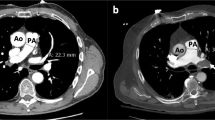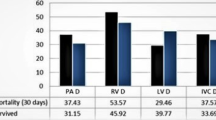Abstract
A left-bulging atrial septum (AS) is an abnormal sign indicating hemodynamic overloading of the right heart. We tried to evaluate whether computed tomography (CT)-derived AS bulging and ventricular septum (VS) bowing signs would be used to identify patients with acute pulmonary embolism (PE) and significant hemodynamic derangements. In the prospective registry, 208 consecutive patients with a first episode of acute PE diagnosed by chest CT were grouped by clinical hemodynamic assessment: massive or submassive PE (Group 1), and small PE (Group 2). The curvatures of the AS and VS, and the diameters of right ventricle (RV) and left ventricle were measured on chest CT. Group 1 showed higher degrees of echocardiographic RV dysfunction, and abnormal CT-derived VS and AS curvatures versus Group 2. An abnormal VS bowing sign was observed in 32 (32.7 %) and 6 (5.5 %) patients in Groups 1 and 2, respectively (P < 0.001). An abnormal AS bulging sign was observed in 59 (60.2 %) and 32 (29.1 %) patients in Groups 1 and 2, respectively (P < 0.001). An algorithm was designed to predict clinically significant hemodynamic abnormality based on these signs. The patients deemed “higher risk” exhibited higher 90-day all-cause mortality than patients in the lower-risk group (P = 0.029). Conventional chest CT-derived hemodynamic findings, including abnormal AS and VS signs, can be used to identify high-risk patients with acute PE and to predict early mortality.





Similar content being viewed by others
References
Torbicki A, Perrier A, Konstantinides S et al (2008) Guidelines on the diagnosis and management of acute pulmonary embolism: the task force for the diagnosis and management of acute pulmonary embolism of the European Society of Cardiology (ESC). Eur Heart J 29:2276–2315
Jaff MR, McMurtry MS, Archer SL et al (2011) Management of massive and submassive pulmonary embolism, iliofemoral deep vein thrombosis, and chronic thromboembolic pulmonary hypertension: a scientific statement from the American Heart Association. Circulation 123:1788–1830
Agnelli G, Becattini C (2010) Acute pulmonary embolism. N Engl J Med 363:266–274
Goldhaber SZ, Bounameaux H (2012) Pulmonary embolism and deep vein thrombosis. Lancet 379:1835–1846
Ribeiro A, Lindmarker P, Juhlin-Dannfelt A et al (1997) Echocardiography Doppler in pulmonary embolism: right ventricular dysfunction as a predictor of mortality rate. Am Heart J 134:479–487
Schoepf UJ, Kucher N, Kipfmueller F et al (2004) Right ventricular enlargement on chest computed tomography: a predictor of early death in acute pulmonary embolism. Circulation 110:3276–3280
Ellis K, Kanter IE, King DL et al (1970) The atrial septal sign: a neglected aid in the interpretation of angiocardiograms. Am J Roentgenol Radium Ther Nucl Med 109:37–50
Braunwald E, Fishman AP, Cournand A (1956) Time relationship of dynamic events in the cardiac chambers, pulmonary artery and aorta in man. Circ Res 4:100–107
Tei C, Tanaka H, Kashima T et al (1979) Echocardiographic analysis of interatrial septal motion. Am J Cardiol 44:472–477
Tei C, Tanaka H, Kashima T et al (1979) Real-time cross-sectional echocardiographic evaluation of the interatrial septum by right atrium-interatrial septum-left atrium direction of ultrasound beam. Circulation 60:539–546
Armstrong WF, Ryan T, Feigenbaum H (2010) Feigenbaum’s echocardiography. Lippincott Williams & Wilkins, Philadelphia
Contractor S, Maldjian PD, Sharma VK et al (2002) Role of helical CT in detecting right ventricular dysfunction secondary to acute pulmonary embolism. J Comput Assist Tomogr 26:587–591
Araoz PA, Gotway MB, Trowbridge RL et al (2003) Helical CT pulmonary angiography predictors of in-hospital morbidity and mortality in patients with acute pulmonary embolism. J Thorac Imaging 18:207–216
van der Meer RW, Pattynama PM, van Strijen MJ et al (2005) Right ventricular dysfunction and pulmonary obstruction index at helical CT: prediction of clinical outcome during 3-month follow-up in patients with acute pulmonary embolism. Radiology 235:798–803
Lang RM, Bierig M, Devereux RB et al (2005) Recommendations for chamber quantification: a report from the American society of echocardiography’s guidelines and standards committee and the chamber quantification writing group, developed in conjunction with the European association of echocardiography, a branch of the European society of cardiology. J Am Soc Echocardiogr 18:1440–1463
Rudski LG, Lai WW, Afilalo J et al (2010) Guidelines for the echocardiographic assessment of the right heart in adults: a report from the American Society of Echocardiography. Endorsed by the European Association of Echocardiography, a registered branch of the European Society of Cardiology, and the Canadian Society of Echocardiography. J Am Soc Echocardiogr 23:685–713
Furlan A, Aghayev A, Chang CC et al (2012) Short-term mortality in acute pulmonary embolism: clot burden and signs of right heart dysfunction at CT pulmonary angiography. Radiology 265:283–293
Apfaltrer P, Bachmann V, Meyer M et al (2012) Prognostic value of perfusion defect volume at dual energy CTA in patients with pulmonary embolism: correlation with CTA obstruction scores, CT parameters of right ventricular dysfunction and adverse clinical outcome. Eur J Radiol 81:3592–3597
Hama Y, Yakushiji T, Iwasaki Y et al (2005) Small left atrium: an adjunctive sign of hemodynamically compromised massive pulmonary embolism. Yonsei Med J 46:733–736
Ocak I, Fuhrman C (2008) CT angiography findings of the left atrium and right ventricle in patients with massive pulmonary embolism. AJR Am J Roentgenol 191:1072–1076
He H, Stein MW, Zalta B (2006) Computed tomography evaluation of right heart dysfunction in patients with acute pulmonary embolism. J Comput Assist Tomogr 30:262–266
Henzler T, Krissak R, Reichert M et al (2010) Volumetric analysis of pulmonary CTA for the assessment of right ventricular dysfunction in patients with acute pulmonary embolism. Acad Radiol 17:309–315
Becattini C, Agnelli G, Vedovati MC et al (2011) Multidetector computed tomography for acute pulmonary embolism: diagnosis and risk stratification in a single test. Eur Heart J 32:1657–1663
Lu MT, Demehri S, Cai T et al (2012) Axial and reformatted four-chamber right ventricle-to-left ventricle diameter ratios on pulmonary CT angiography as predictors of death after acute pulmonary embolism. AJR Am J Roentgenol 198:1353–1360
Morris MF, Gardner BA, Gotway MB et al (2012) CT findings and long-term mortality after pulmonary embolism. AJR Am J Roentgenol 198:1346–1352
Uhm JS, Jung HO, Kim CJ et al (2012) Comparison of clinical and imaging characteristics and outcomes between provoked and unprovoked acute pulmonary embolism in Koreans. J Korean Med Sci 27:1347–1353
Kang DK, Thilo C, Schoepf UJ et al (2011) CT signs of right ventricular dysfunction: prognostic role in acute pulmonary embolism. JACC Cardiovasc Imaging 4:841–849
Conflict of interest
None.
Author information
Authors and Affiliations
Corresponding author
Rights and permissions
About this article
Cite this article
Kim, MJ., Jung, H.O., Jung, J.I. et al. CT-derived atrial and ventricular septal signs for risk stratification of patients with acute pulmonary embolism: clinical associations of CT-derived signs for prediction of short-term mortality. Int J Cardiovasc Imaging 30 (Suppl 1), 25–32 (2014). https://doi.org/10.1007/s10554-014-0428-6
Received:
Accepted:
Published:
Issue Date:
DOI: https://doi.org/10.1007/s10554-014-0428-6




